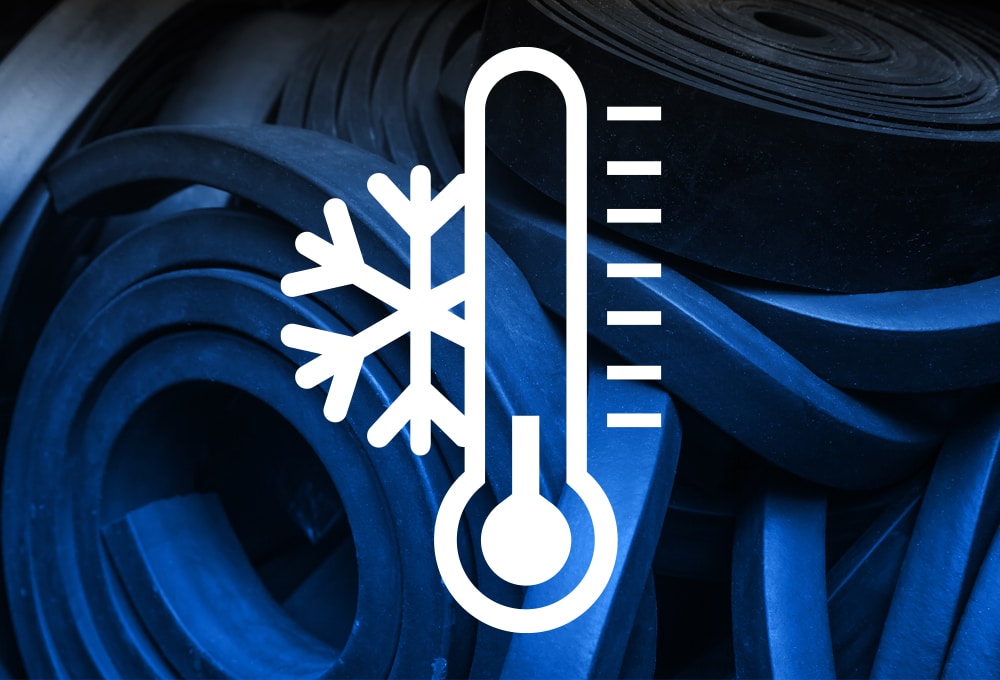
The technical answer is, no, rubber cannot freeze…
.. however it does get hard and brittle.
The scientific definition of to freeze involves a phase shift of liquid into solid forming crystals. This phase occurs as a result of the temperature reaching the freezing point of the substance. As rubber polymers cannot form crystalline structures, they do not by definition freeze. The physical property changes of rubber in low temperatures may however affect the performance of the rubber product.
Which rubbers perform best in extreme temperatures?
Silicone rubber withstands high and low temperatures far better than organic rubbers. Silicone rubber can be used indefinitely at 150°C with almost no change in its properties. It withstands use even at 200°C for 10,000 hours or more, and some products can withstand heat of 350°C for short periods. Silicone rubbers are thus suitable as a material for rubber components used in high temperature environments. This is why you’ll see silicone rubber moulds being used in kitchens as moulds and mats used in ovens.
Silicone rubber also has excellent resistance to cold temperatures. The embrittlement point of typical organic rubbers is between -20° and -30°C, compared to -60° to -70°C for silicone rubbers. Even at temperatures at which organic rubbers turn brittle, silicone rubber remains elastic. Some products withstand extremely low temperatures of -100°C and below.
Silicone Rubber and Fluorinated Silicone Rubber in cold temperatures
Silicone rubbers have been widely used in power insulation systems due to having properties such as excellent electrical insulation and weather resistance. Fluorinated silicone rubber (fluorosilicone rubber) has been widely utilised in harsh environments for electrical insulation, especially in winter environments where extremely low temperatures are commonplace and can persist for extended periods of time.
In cold environments, traditional silicone rubber cannot meet the performance requirements of electrical insulation applications. Extremely low temperatures influence the performance of rubber insulation materials and can potentially cause catastrophic failure in seals and pipes.
Research shows that fluorosilicone rubber possesses even higher tensile properties, elongation performance, lower hardness, and enhanced elasticity than silicone rubber. Fluorosilicone rubber also performs better and for longer periods as an electrical insulator under extreme cold conditions.
So, silicone rubber is ideal for all but the very coldest, harshest and most extreme environments, where fluorinated silicone rubber offers even greater performance.
How is Rubber tested for behaviour in low temperatures?
There is a test – called T.R or Temperature Retraction (ISO 2921), where the properties of different materials can be tested at -70°C & mechanical properties recorded. See: https://www.iso.org/standard/72779.html
The document specifies a method for the determination of the temperature-retraction characteristics of stretched vulcanized rubber. It does not cover thermoplastic rubbers, since many thermoplastic elastomers have a yield point in the range of 5% to 20% elongation.
This TR Test is an industry testing method for evaluation properties at low temperatures. The test shows the brittleness point of a material & also the compression set & recovery behaviour of elastomers. Test specimen pieces are normally tested in elongation mode, in a cold liquid bath for 10 minutes.
It’s a fact…
Here at J-Flex, high performance products are the norm – we once actually supplied some Extruded Silicone Profiles to a European Space Agency project where our raw material supplier had to guarantee the material for -80°C.
Contact us if you need help with any rubber products that perform to extremes!

Could you live in Nuuk City – the capital of Greenland?